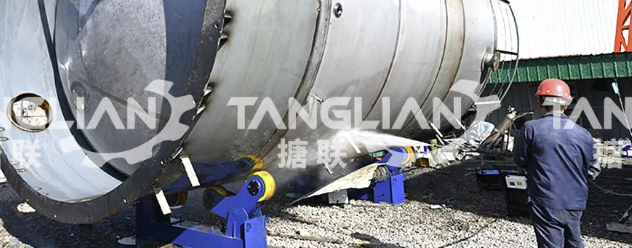Product FAQ
Method for cleaning glass lined reaction kettle
The materials involved in the reaction in the glass-lined reactor can lead to the accumulation of dirt inside the equipment. However, if the scale is severe, it will corrode the surface of the equipment and reduce its service life. Therefore, enterprises need to regularly clean the reactor. There are three commonly used cleaning methods for reaction vessels, namely mechanical cleaning, chemical cleaning, and manual cleaning. The specific methods can be selected through the following introduction.
1. Mechanical cleaning:
Using a high-pressure cleaning device, high-pressure water flow is used to wash through the nozzle, shattering the hard scale on the inner wall of the glass lined reaction kettle and the surface of the mixer, completely peeling off and removing it. The principle of high-pressure water jet cleaning is to compress water to high pressure, and then release it through a nozzle installed on the cleaning robot that extends into the pot. The pressure energy is converted into the kinetic energy of water flow, and through this energy, the dirt on the wall is impacted to achieve the effect of cleaning and removal. Different from the previous two cleaning methods, high-pressure water jet cleaning is a pure physical cleaning method that uses water as the medium, which is very low in cost but highly efficient. The high-pressure water cleaning takes a very short time, which can save a lot of cleaning time compared to manual cleaning in a year. If this time is used for production, it will generate significant economic benefits. Meanwhile, high-pressure water will not cause any damage to the inner walls of the equipment. At present, high-pressure water jet cleaning has gradually become the mainstream of cleaning methods in the chemical industry.
2. Chemical cleaning:
The first thing to know is the composition of the scale sample inside the glass-lined reactor. A better method is to sample and analyze it. After determining the composition of the dirt, conduct a test first, select a cleaning agent, and confirm through the test that it will not cause corrosion to the equipment metal. Then, a temporary circulating device is installed on site to circulate the cleaning solution inside the equipment and remove dirt. First, rinse the mixing paddle and inner wall with an appropriate amount of water and drain thoroughly. Flush the reaction kettle with solvent through a pressurized device. If the cleaning effect is not achieved, add an appropriate amount of solvent to the reaction kettle, stir and reflux until the cleaning requirements are met, and then release the solvent. Afterwards, rinse the inner wall of the reaction kettle with a certain amount of solvent and release it.

3. Manual entry and manual clearance:
Low cost is its major advantage, but it requires several hours of ventilation before entering the glass-lined reactor. During the cleaning process, the oxygen concentration in the pot must also be monitored at any time, which poses a risk of hypoxia; At the same time, manual scraping not only fails to completely clean, but also causes sliding damage to the inner wall of the reaction kettle, objectively causing further adhesion of residues. Manual cleaning can also cause product hygiene issues. Generally speaking, the time required to clean a reactor is about half a day to one day.
The three cleaning methods for glass lined reaction vessels have both advantages and disadvantages. For example, the mechanical cleaning method does not corrode the reaction vessel and is relatively reliable, but it is time-consuming and labor-intensive, delaying the operation of the enterprise; The chemical cleaning method has a very good cleaning effect, but if the selected substance is not appropriate, it can cause equipment damage, such as hydrochloric acid can cause internal wall scale explosion; The manual cleaning effect is average and there are certain risks, so this method is not recommended.
Categories
News
Contact Us
E-mail: service@chinareactor.com
Add: Hongshan Town Industrial Park, Chongzheng Road, Zichuan District, Zibo City, Shandong Province